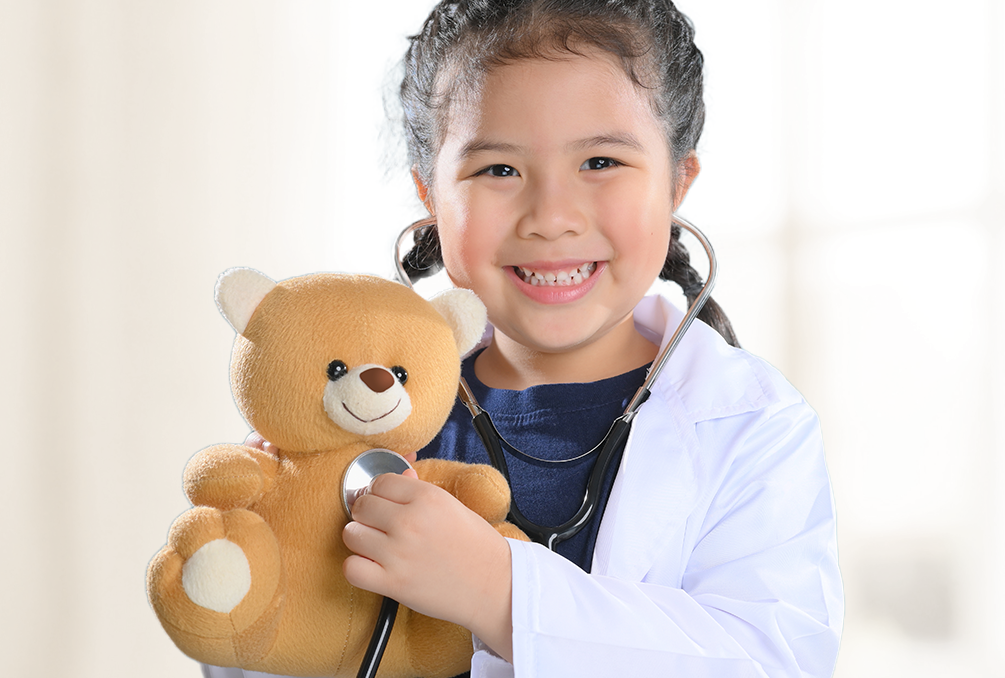


To learn more about common childhood illnesses and symptoms, select the portion of the body where your child is experiencing symptoms on the diagram below.
To view the list of symptoms, select from the A – Z listing tab below.
Asthma is a common long-term condition that can be well controlled in most children. The severity of asthma symptoms varies between children. Asthma affects airways. A sudden, severe onset of symptoms is known as asthma attack.
Symptoms of asthma include:
Bronchiolitis is a lower respiratory tract infection that affects babies and children under two years old. Bronchiolitis affects bronchioles (smaller airways). It is caused by a virus called RSV (respiratory syncytial virus).
Symptoms of bronchiolitis include:
Chickenpox is a mild disease that most children catch at some point. It is caused by the varicella-zoster virus. Chickenpox is highly contagious and can be passed onto others for about two days before the rash appears to until the blister has burst and crusted over.
If your child has chickenpox, keep them away from public area. One can develop chickenpox within 10-21 days after being near someone who has chickenpox.
Symptoms of chickenpox include:
Getting the chickenpox (varicella) vaccine can reduce the risk of your child contracting the highly contagious chickenpox infection.
Clubfoot is a condition whereby the forefoot (part of the foot connected to the lower leg bone) is abnormally twisted relative to the lower leg bone to point inward and downward. This may happen with one or both feet.
There are two types of Clubfoot:
Symptoms of clubfoot include:
The common cold is a mild, self-limiting, upper respiratory tract infection. Symptoms of common cold include:
Infants may also be irritable, have snuffles, and difficulty with feeding.
When should you seek help from a paediatrician:
Conjunctivitis is a common eye infection where the conjunctiva (thin, clear membrane that protects the eyes) become inflamed as the result of a bacterial or viral infection.
Symptoms of conjunctivitis include:
Constipation is very common and can occur in children of all ages. Constipation means passing hard stools with difficulty and less often than normal. Abdominal pain is a common symptom too.
Croup is a common respiratory tract infection in children between the age of six months and 12 years old. It is an infection that affects the child’s upper airway (larynx, trachea, bronchus).
Croup is caused by respiratory viruses. Viral croup usually resolves within one week.
Symptoms of croup include:


Most children have occasional loose stools. However, diarrhoea is when your child frequently passes unformed, watery stools. Diarrhoea and vomiting can be more serious in babies because they can easily loose too much fluid from their bodies and become dehydrated.
When should you seek help from a paediatrician:
Diphtheria is a bacterial infection caused by Corynebacterium diphtheriae. This infection primarily affects the throat and nose but can spread to the skin and other parts of the body.
Symptoms of diphtheria include:
Preventing diphtheria primarily involves vaccination. Ensure that your child receives the diphtheria vaccination that is part of the routine childhood immunisation schedule in Malaysia.
Ear infections are common in babies and toddlers. Most ear infections are caused by virus and often after a bout of the common cold.
Ear infections can be painful and can sometimes cause fever. A child may rub or pull at their ears. Young babies cannot always tell where the pain is coming from and may just cry and seem irritable.
When should you seek help from a paediatrician:
Eczema is also known as atopic dermatitis. The onset of eczema is most common when the infant is between 1 to 3 months old.
Symptoms of eczema include:
Eczema is usually recurrent. The rash gets better, then reappear soon after.
Eczema rash is often itchy, so treatment is usually needed for this condition. Moisturisers are often used to treat mild eczema. For severe eczema, a topical steroid cream or ointment may be needed.
Fever happens when the body's internal 'thermostat' raises the body temperature above its normal level. This thermostat is found in a part of the brain called the hypothalamus.
Fever by itself is not an illness; it is usually a symptom of other conditions such as infections (e.g., common cold, influenza, gastroenteritis, tonsillitis).
It is a fever when your child's temperature is at or above one of these levels:
When should you seek help from a paediatrician:
Learn more about fever in children, what causes prolonged fevers, when it is a mere symptom, and it might be a sign of something more serious.


Upset stomach can sometimes be caused by food allergies, but often they are caused by an infection or stomach bug. This is called gastroenteritis. The most common cause of gastroenteritis is usually a virus, such as rotavirus.
When should you seek help from a paediatrician:
Hand-foot-and-mouth (HFMD) is a common infectious disease that is seen in children and infants. The disease is usually mild and self-limiting.
HFMD is contagious. The virus spreads from person to person through faecal-oral route and the infected person's nose and throat secretions, fluid from scabs or blisters.
Symptoms of HFMD include:
When should you seek help from a paediatrician:
A heat rash appears after exposure to heat or sweat. However, it usually disappears after a cool environment is provided to the affected child, such as wearing loose clothing or switching on air-conditioning.
A heat rash typically does not necessitate treatment. If symptoms worsen, they are usually attributed to other illnesses. Bring your child to a paediatrician if you have concerns about your child’s condition.
Commonly known as the flu, influenza is caused by a virus and spreads through the air when infected people cough/sneeze.
Symptoms of influenza include:
If you notice these symptoms, seek your doctor’s help for medication. Most influenza cases can be well managed at home with medication, rest, and proper fluid intake by the child.
Getting flu vaccines every year can reduce the risk of contracting influenza for various common strains.


Pertussis or whooping cough is an acute bacterial infection caused by the bacteria Bordetella pertussis. This infection affects the respiratory tract and is highly contagious. It spreads through respiratory droplets and by direct contact with fluids from the nose or mouth of infected person.
Serious cases and fatalities are often observed in early infancy stage.
Symptoms of pertussis include:
Ensure that your infant receives the pertussis vaccination at 2, 3 and 5 months of age according to the Malaysian National Immunisation Programme.
Pneumonia is an infection that affects one or both lungs. It can usually be triggered by cold or flu bouts.
Pneumonia causes fluid or pus to fill the air sacs of the lungs. It obstructs the normal exchange of gas inside the lungs, which leads to low levels of the oxygen in the blood and impaired removal of carbon dioxide from the body.
Young children are considered most susceptible to pneumonia.
Symptoms associated with pneumonia differ considerably depending on the cause and the health condition of the child. They may include:


The build-up of sinus fluids allows viruses and bacteria to grow which may cause a sinus infection.
Symptoms of sinusitis include:
Skin allergy can be acknowledged if the onset of the rash is after exposure to an allergen, which causes the allergic reaction. The reaction may occur within minutes, or between 4 to 6 hours after the exposure.
Allergens are usually substances or foods that trigger an allergic reaction. Common culprits of an allergic reaction in children are certain foods such as eggs, seafood, and peanuts.
Symptoms of an allergic skin reaction include:
‘Sticky eyes’ is a common condition in newborn babies and young children while their tear ducts are developing. Symptom includes sticky stuff in the corner of their eyes or eyelashes.
Strep throat is an infection caused by the bacteria Streptococcus pyogenes.
Symptoms of strep throat include:
Take your child to a paediatrician for a strep test if he/she shows the symptoms above.
Swollen gums are a typical sign of gum disease and usually appear reddish or purplish due to increased blood flow to the area. They could also seem shiny or smooth, and they typically bleed.
If your child’s gum swelling persists for more than a few days or causes significant pain, you should take him/her to visit a dentist or periodontist.
Located on each side of the back of the throat, tonsils are part of the immune system that produce antibodies to fight germs that attack the mouth.
Tonsillitis is a condition when the tonsils are infected and enlarged. Viral infection is the main cause of tonsillitis.
Symptoms of tonsillitis include:
Torticollis (also called Wry Neck) is when the baby’s head is tilted. The chin points to one shoulder, while the head tilts toward the opposite shoulder.
Congenital Torticollis occurs when the neck muscle that runs up and toward the back of the baby’s neck is shortened. Torticollis may be present soon after birth due to scar tissue and tightness of the muscle on one side of the neck, or it may occur later in childhood.
Symptoms of torticollis include:
Urinary tract infection (UTI) is a common bacterial infection of the bladder or kidneys. It is a common cause of fever in young children. UTI can be suspected especially when no other obvious sources of fever are identified.
Symptoms of UTI in children include:
Take your child to a paediatrician for if he/she shows the symptoms above. UTI in children must be treated because untreated UTI poses a risk of kidney damage.






